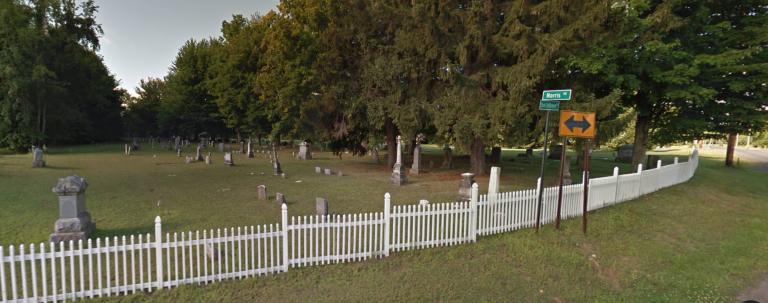If you find errors OR have additional information about this site, please send a message to contact@waynehistorians.org.
York Settlement Cemetery
| Historic Site #: | 04-008 (Exists) Type: B1 | Town: | Huron | ||
| Site Name: | York Settlement Cemetery | GPS Coordinates: | 43.19983, -76.93944 | ||
| Address: | 9353-9341 York Settlement Rd, Huron, NY 14516 | ||||
| Description: | |||||
| The York Settlement Cemetery is one of two cemeteries in the Town of Huron that is still active. York Settlement was established in York Settlement Cemetery Surnames A-G York Settlement Cemetery Surnames H-Q York Settlement Cemetery Surnames R-Z | |||||
 |
| York Settlement Cemetery. At the corner of York Settlement and Norris Roads. |
| Historic narrative: | |||||
| A sampling of the many local surnames from both Rose and Huron found within the York Settlement Cemetery: Clingerman; Clum; Davenport; Dunbar; Durham; Gatchell; Jewell; Kelley; Perkins; Powell; Riggs; Seager; Shannon; Virts; Wager; York. From THE FIRST SETTLERS – WESTWARD HO! by Beulah L. Morrell (Huron Historian 1960-1971) Part Four. Robert York, of New Portland, Maine, was a veteran of the Revolutionary War. As a bonus for his services, he was given a tract of land by a government which had more land than money. This family left Maine for New York State on May 20, 1812, and arrived here October 20. The oxen and carts carried them the journey of nearly 800 miles. Benjamin York, the oldest son of Robert, with his wife, Martha Churchill York, and the brothers, John, Robert, and Thomas, made up the party. Benjamin and Martha built a cabin on what we call the York Settlement Road. Here three of their six children were born. When this cabin burned a frame house was built. Around a central chimney, five fireplaces were made, one having a built-in oven. This house, although changed, is still in use as the home of the William Jewell family. [at the time of this writing circa 1970] When the land was cleared, a fine grove of 12 acres of chestnut trees was left standing. Near this grove, the family burial plot was laid out and later became the York Cemetery Incorporated. Land on the edge of the grove was given for a school and one of the York girls became its first teacher. Each succeeding generation found another York occupying the same position. After centralization, this school, as so many others, became a dwelling. The York Farm had the first apple orchards in our area. Varieties we no longer know were growing there – Pound Sweets, Seek-No-Furthers, Jill Flowers, Bell Bonnes, and Russets. A drying house eight by twelve feet was built. It had a hand peeler and a wood-burning heater. The fruit, when dried, was sold to a store in Sodus. Chestnuts from the grove brought an annual income of $500 to $700. They were gathered on shares and the women had a “watch and weigh” shed where the figures from the nuts to be divided -half to the gatherers and half to the owners. Honey was also one of the chief products from the farm. The Yorks were said to produce the finest wool around. I believe that the women cared for the sheep because of the story told that the York girls while guarding their sheep out on the hills, would sing and could be heard five miles away on a clear day. The year 1816 was hard on these early settlers. It is referred to as “the year without a summer” since there was a frost in every month. Fish and game made up a large part of the diet. What corn there was had to be saved for seed. Turnips were the only thing that survived to make a crop. So many turnips for eaten that for the next four generations the children refused to touch one. Much of the York story was given me by Beulah Jewel Himes, who is a direct descendent of this hardy family, as are the Seagers, the Kelley’s, the Durhams, and countless others. | |||||
